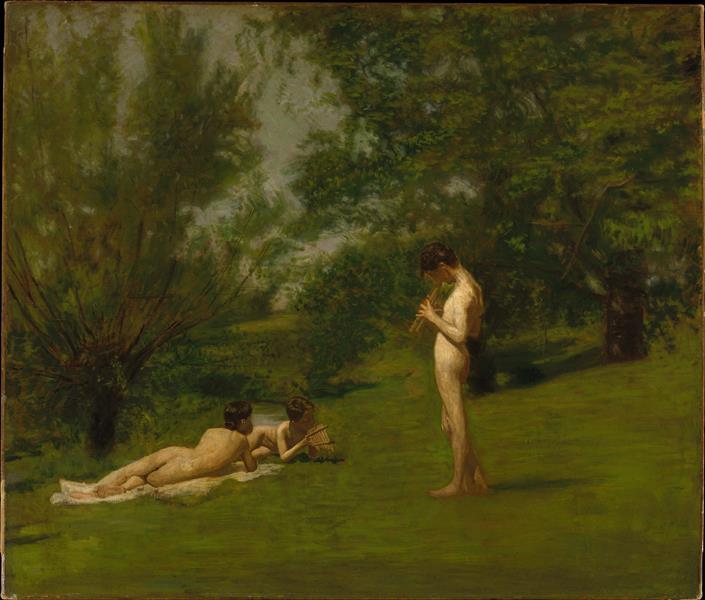Tanım
Thomas Eakins' 1883 painting "Arcadia" is part of a crucial moment in the development of American art, where an understanding of realism is intertwined with a search for truth and human nature. Eakins, acclaimed for his ability to Capturing the human figure and anatomy in a way that few artists of his time achieved, this work employs a series of elements that invite a deep reflection on the ideal of pastoral life and the celebration of natural beauty.
In Arcadia, Eakins presents a serene atmosphere that evokes the idea of a utopian space, a place where nature and humanity meet in perfect harmony. The painting is composed in a style that reveals the influence of realism, although shades of symbolism are also perceived in the idealized representation of life in nature. The use of color is subtle but effective; the predominant green tones evoke the freshness and liveliness of the countryside, while browns and ochres bring warmth to the scene. This color choice not only creates a visually appealing environment, but also establishes a dialogue with the theme of the work: the search for a refuge in the purity of nature.
The composition of “Arcadia” is characterized by a balanced arrangement of figures and landscapes. Although there are no characters with names or clear stories, the two human figures in the foreground are representative and at the same time universal in their symbolism. They are positioned in the central part, interacting with their surroundings in a way that suggests a moment of contemplation and connection with the earth. Their poses are relaxed, inviting the viewer to experience the repose that the characters seem to enjoy. This focus on the human figure reflects Eakins’ interest in the study of the body and movement, something that is recurrent in his work.
Eakins also introduces elements of subtle symbolism through iconography. The scene suggests the idea of an earthly paradise, an “Arcadia” where simple moments and stillness are valued. This dilemma about idealized life in nature versus rapidly expanding modernity still resonates today. Paintings of the period, such as Botticelli’s “Primavera,” share this quest for the idealized, though Eakins brings a modern sensibility by integrating the human figure into its surroundings in a more realistic and palpable way.
Eakins' process in creating his works was, as is well known, meticulous and dedicated. His commitment to anatomical accuracy and the study of naturalism is evident in the naturalness of the poses and the texture of the skin, which contrasts with the softness of the landscapes that serve as the work's background. The way he captures light and shadow accentuates the three-dimensionality of the figures, making them seem almost alive.
In short, Thomas Eakins' Arcadia is much more than a simple visual representation; it is an invitation to contemplate the interrelationship between the human being and his environment. Through his ability to fuse the human figure with an idealized pastoral landscape, Eakins offers us a glimpse into a world that may seem distant in the context of the increasing urbanization and modernity of his time. His legacy in American painting lies not only in his masterful technique, but also in his ability to make beauty and truth resonate in each of his works, and Arcadia is a testament to this aesthetic and philosophical quest.
KUADROS ©, a famous painting on your wall.
Hand-made oil painting reproductions, with the quality of professional artists and the distinctive seal of KUADROS ©.
Painting reproduction service with satisfaction guarantee. If you are not completely satisfied with the replica of your painting, we will refund 100% of your money.

